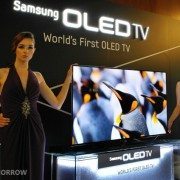OLED TV cost saving, the alternative is co-planar structure
Current AMOLED panel market is mainly led by either Samsung Display or LG Display, mass producing the LTPS backplane for mobiles and Oxide backplane for TVs.
Though the AMOLED panel market for mobiles has established stable position in the business beyond LCD panel market, the market for TV is having difficulties in settling for its high price compared to the LCD/LED TV, requiring pressing technological development to lower the cost.
As a counterplan for this, the LG Display received a considerable attention at the SID 2014 by exhibiting 65-inch curved UHD OLED TV applying not the existing etch stopper layer (ESL) structure but the co-planar structure.
According to the “2014 AMOLED Backplane Technical Report” published by the UBI Research, it was analyzed that there is a difference in the investment expenses by about $ 80 million when making the additional investment in oxide TFT AMOLED line of co-planar for a-Si LCD line against the supplementary investment in oxide TFT AMOLED for LCD line. (For Gen 8) It was also suggested that the co-planar structure is appropriate for the oxide TFT structure which can make the best use of the backplane and color filter equipment of the previous a-Si LCD line as the mask can be used under 6 layers.
In addition, the core issue of the AMOLED industry which is a technological concern over the flexible LTPS applied to the flexible display was examined along with the latest technology trend analysis of LTPS, oxide, and organic TFT in the “2014 AMOLED Backplane Technical Report”.





댓글을 남겨주세요
Want to join the discussion?Feel free to contribute!